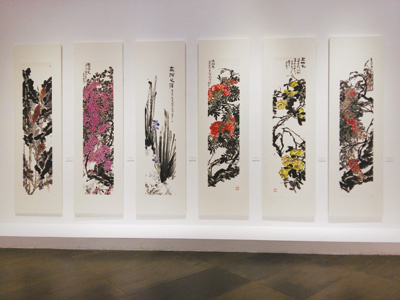
Wang Haiying why.art@163.com PRESENTING new developments in Chinese flower-and-bird paintings, a major exhibition entitled “Natural Beings in Heart: Contemporary Chinese Flower-and-bird Painting,” which shows about 193 Chinese ink-wash paintings by nine artists from several cities in China, is now on display at the Guangdong Museum of Art through March 12. All these works have been made in recent years, mostly since 2010. The artists, Lin Lan, Li Yunlei, Xu Xiaobin, Xu Dunping, Yin Shuyu, Zhou Wusheng, Li Xuesong, Liu Haiyong and Cao Yuanping, were all born in the 1970s and are now some of the leading flower-and-bird painters in China. Fascinating new forms With a brilliant history of more than 2,000 years, Chinese flower-and-bird painting includes paintings that portray not only flowers and birds, but also all kinds of plants and animals. Since the beginning of the 20th century and especially after the 1980s, Chinese painters have developed more and more painting techniques and art forms, owing to the influence of modern artistic ideas and trends. The exhibition offers representative examples of this change. For instance, Lin (born in Guangdong), the vice president of Guangzhou Academy of Fine Arts, applies elegant and light colors on golden paper, creating new visual forms for Chinese flower-and-bird painting. Her series “Snow-white Flowers” features six lotus flowers in six individual frames. With the seeds painted in silver, the flowers all shine with brilliance against the golden background. Innovative compositions also generate new forms. By arranging the animals and plants in innovative layouts, Zhou, a professor at Tianjin Academy of Fine Arts, creates new and appealing forms. He was selected as an “Innovative Expert” for the 131 Project in China. Precious qualities of nature New art forms partly derive from changes in the natural and social environments. Along with the growth of the world’s population as well as the development of global industrialization and urbanization in the 20th century, artists have gradually discovered more about nature. For example, Li Yunlei, artist of Zhejiang Cultural Center, presents the beauty of nature by employing various bright colors to depict flowers. Biodiversity is a valuable quality of nature. To demonstrate the biodiversity of nature, Xu Dunping (born in Guangdong), vice dean of the Chinese Painting Institute of Guangzhou Academy of Fine Arts, enjoys painting all kinds of plants such as passion flowers, golden flowers and fire flowers. His series “Sketches at Xishuangbanna” illustrates six kinds of tropical flowers with powerful and bold brushstrokes, showing the charm of diversity and the importance of every single species. Wilderness means the state of an area that is untouched by civilization. Using vigorous and robust brushstrokes, Li Xuesong, artist of Beijing Painting Institute, conveys the vitality of various wild plants in the wilderness such as in a tropical rainforest, on a snowy plateau and deep within the ocean. All living beings are organic. By adopting flying freehand brushstrokes, Liu, professor of China Academy of Fine Arts, showcases the deliciousness of organic melons and fruits. The purity of the ecological environment is crucially important. Cao, lecturer of the Academy of Fine Arts of Central China Normal University, prefers pure colors and white backgrounds, showcasing the fantastic purity of unpolluted nature. Admiring natural beings Realizing the precious qualities of nature which are beneficial to human beings, contemporary artists have become even more passionate for nature, and in turn work to arouse the public’s enthusiasm for protecting the environment. For instance, Yin, editor of Art Observation magazine in Beijing, depicts fruits and flowers with extremely gentle and delicate brushstrokes, revealing his strong love for the beauty of the plants native to southeastern China. A painter’s emotions can be felt through the details of their paintings. By employing elegant brushstrokes and harmonious compositions, Xu Xiaobin (born in Guangdong), first-class national artist of Guangzhou Academy of Fine Arts, extraordinarily portrays various wild birds in romantic and lyrical settings. His brilliant work “Misty Drizzle” depicts three white birds in a rainy forest. With bamboo stems and leaves arranged in melodious rhythms and the birds bathed in dreamlike mist, the painting creates a poetic vision, conveying his intense passion for the romance of nature. The adoration for natural beings is also part of the tradition of Chinese flower-and-bird painting. To help audiences to feel the unique charm of Chinese flower-and-bird painting in a historical atmosphere, the organizers of the exhibition installed ancient furniture and real flowers into one of the exhibition halls. Besides the interior design, the texts are also an attractive part of this exhibition. In his foreword and introductory remarks, the curator of the exhibition Yu Yang, associate professor of Central Academy of Fine Arts, demonstrates not only the cultural value of flower-and-bird painting in the present, but also its great potential in the future. “Gathering extraordinary works from different parts of China, this exhibition reflects the traditional and modern techniques of Chinese ink-wash painting. We believe that it will have a positive influence on the future development of teaching and creation of Chinese flower-and-bird painting,” remarked Li Jinkun, professor of Chinese ink-wash painting and chairman of Guangdong Artists Association. (The author is a researcher at Guangdong Museum of Art) Venue: Halls 5, 6, 8, 9, Guangdong Museum of Art Add: 38 Yanyu Road, Ersha Island, Guangzhou Date: Now through March 12 Time: 9 a.m.-5 p.m., Tuesdays-Sundays Tel: 020-87351468 | 
